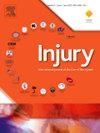Whole blood for old blood: Use of whole blood for resuscitation in older trauma patients
IF 2.2
3区 医学
Q3 CRITICAL CARE MEDICINE
Injury-International Journal of the Care of the Injured
Pub Date : 2025-01-01
DOI:10.1016/j.injury.2024.111758
引用次数: 0
Abstract
Introduction
Older patients are expected to comprise 40 % of trauma admissions in the next 30 years. The use of whole blood (WB) has shown promise in improving mortality while lowering the utilization of blood products. However, the use of WB in older trauma patients has not been examined. The objective of our study is to determine the safety and efficacy of a WB first transfusion strategy in injured older patients.
Methods
Older trauma patients, defined as age ≥55 years old, were reviewed from March 2016-November 2021. Patients that received a WB first resuscitation strategy were compared to those that received a ratio based component strategy. Demographics as well as complications rates, blood product transfusion volumes, and mortality were evaluated. Univariate and multivariable analysis was used to determine independent predictors of mortality.
Results
There were 388 older trauma patients that received any blood products during the study period. A majority of patients received a WB first resuscitation strategy (83 %). Compared to patients that received component therapy, patients that received WB first were more likely female, less likely to have a penetrating mechanism, and had a slightly lower injury severity score. The-30 day mortality rate was comparable (WB 36% vs component 37 %, p = 0.914). While rates of AKI were slightly higher in those that received WB, this did not result in increased rates of renal replacement therapy (3 % vs 2 %, p = 1). Further, compared to patients that received components, patients that were resuscitated with a WB first strategy significantly utilized lower median volumes of platelets (0 mL vs 197 mL, p < 0.001), median volumes of plasma (0 mL vs 1253 mL, p < 0.001, and median total volume of blood products (1000 mL vs 2859 mL, p < 0.001).
Conclusion
The use of WB in the older trauma patient appears safe, with mortality and complication rates comparable to component therapy. Blood product utilization is significantly less in those that are resuscitated with WB first.
全血换旧血使用全血对老年创伤患者进行复苏。
导言:预计在未来 30 年内,老年患者将占创伤住院患者的 40%。全血(WB)的使用在降低血液制品使用量的同时也有望提高死亡率。然而,尚未对老年创伤患者使用全血进行研究。我们研究的目的是确定老年创伤患者首次输注全血策略的安全性和有效性:对 2016 年 3 月至 2021 年 11 月期间的老年创伤患者(定义为年龄≥55 岁)进行了回顾性研究。将接受 WB 首次复苏策略的患者与接受基于比例成分策略的患者进行比较。对人口统计学、并发症发生率、血制品输注量和死亡率进行了评估。采用单变量和多变量分析确定死亡率的独立预测因素:在研究期间,共有 388 名老年创伤患者接受了任何血液制品。大多数患者接受了 WB 首次复苏策略(83%)。与接受成分疗法的患者相比,首先接受 WB 的患者多为女性,穿透性机制的可能性较小,受伤严重程度评分略低。30 天死亡率相当(WB 36% vs 组件 37%,P = 0.914)。虽然接受 WB 治疗的患者发生 AKI 的比例略高,但这并没有导致肾脏替代治疗的比例增加(3% 对 2%,P = 1)。此外,与接受成分复苏的患者相比,首先接受 WB 复苏的患者使用的血小板中位数(0 mL vs 197 mL,p < 0.001)、血浆中位数(0 mL vs 1253 mL,p < 0.001)和血液制品总量中位数(1000 mL vs 2859 mL,p < 0.001)都明显较低:结论:在老年创伤患者中使用 WB 似乎是安全的,死亡率和并发症发生率与成分疗法相当。结论:在老年创伤患者中使用 WB 似乎是安全的,死亡率和并发症发生率与成分疗法相当。
本文章由计算机程序翻译,如有差异,请以英文原文为准。
求助全文
约1分钟内获得全文
求助全文
来源期刊
CiteScore
4.00
自引率
8.00%
发文量
699
审稿时长
96 days
期刊介绍:
Injury was founded in 1969 and is an international journal dealing with all aspects of trauma care and accident surgery. Our primary aim is to facilitate the exchange of ideas, techniques and information among all members of the trauma team.

 求助内容:
求助内容: 应助结果提醒方式:
应助结果提醒方式:


